In these difficult times the restrictions on unnecessary travel and being out of our own properties are making foraging in an urban environment more difficult. Those of us lucky enough to have a garden might be thinking it looks like a slightly overgrown adventure playground and be considering a big weeding session, but stop before you consign those plants to the green bin! Many of our most vexatious garden weeds are great edibles, and are especially plentiful in the spring. To help you get the most out of your garden forage we look at five of the best.
Nettles
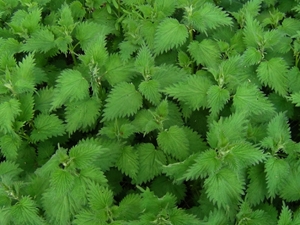
These need no introduction, we all know what they look like and feel like, ouch! If they don’t sting you then they are probably ‘dead nettles‘, a group of plants in the mint family. Being easy to identify is a great start, and as with all our top 5 they are plentiful, growing in abundance in moist areas associated with human habitation. They particularly enjoy the sites of old buildings, benefiting from the high phosphorous and nitrogen levels in these areas. Our UK nettle Urtica dioica ssp dioica (one of 6 subspecies worldwide) is well provisioned with hollow stinging hairs so 1st question is, how to pick them? Either with gloves or carefully is the answer. Gardening gloves will keep the stings out, thin latex gloves won’t. Or use your forefinger and thumb to pinch out the top few leaves, as these are the best anyway, being careful not to brush against the plants with the backs of your hands.
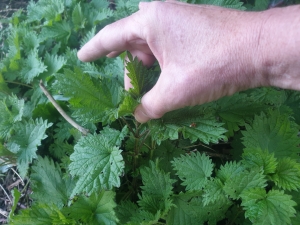
Once harvested the nettles come with many nutritional benefits. They are 25% by dry weight protein, contain good levels of vitamins A, B, C, E and K, as well as essential elements such as calcium, potassium, magnesium, sulphur, iron, copper and manganese. To top it off there are high levels of Omega 3 oils (good for brain development and arthritis, also found in fish oils).
A couple of words of caution we have to use with nettles is only eat them before they flower as there are some suggestions that they can irritate the bladder, and for the same reason they should be avoided during pregnancy.
What to do with nettles? The stings are easily dealt with by heating (cooking) or crushing. Their flavour could be described as distinct and a cross between spinach and cucumber. Eat them raw after a good squashing, steam them and use them as a spinach substitute, use in the traditional nettle soup, make crunchy nettle crisps, make a nettle tea (steep young nettle leaves in hot water) or nettle beer (recipe coming soon).
Wood avens
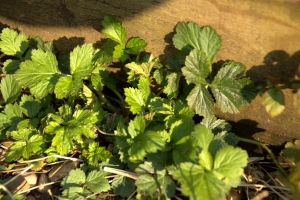
This is the one that looks a bit like a strawberry but when you try to pull it up the leaves come off and the rest of the plant stays firmly in the ground. It is actually a Geum, the wild version of the common garden flower. The strawberry style leaves have smaller pairs of ‘leaflets’ running down the stems, and the small flowers are yellow with 5 petals, turning into fuzzy balls later. It loves lurking between slabs and in awkward places and will soon take over a flower bed given a chance. Not one for the salad bowl as the leaves are tough and bitter, but it is the roots we are after here.
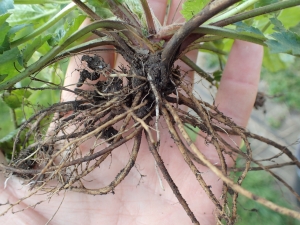
That mass of roots that securely anchors the plant in the soil have a hidden flavour. Give them a rub and a scrape to expose the raw flesh and you will soon be surrounded by the heady smell of cloves with its reminders of Christmas and less happily the dentist. Clean up some roots and add them where you would add cloves and voila, your own spice from the garden. They don’t retain their flavour when dried so use them fresh where you can (they are always to hand in the garden). The amount of root equivalent to one clove is very variable depending on the size of the root, moisture levels, and time of the year, start with a few cm and experiment. For a longer lasting flavour try making wood avens syrup, an excellent addition to drinks, pancakes, and ice cream.
Chickweed
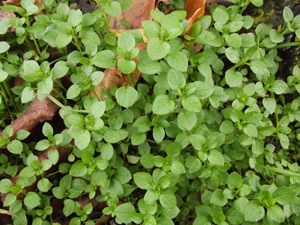
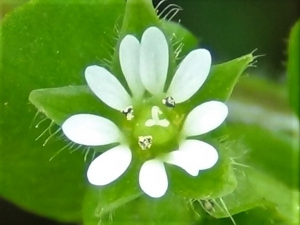
Stellaria media to give it its scientific name is an all year round plant when there is some moisture available. Its not keen on hard frosts or drought. Apart from that it will keep growing, and growing, and growing. It lies flat on the ground, but climbs over other plants where it can turning into a mass of stringy bright green leaves and stems. The leaves are simple and 3mm to 10mm in length, the white flowers are only a few mm across, appearing to have 10 petals but actually these are 5, with splits down the middle.
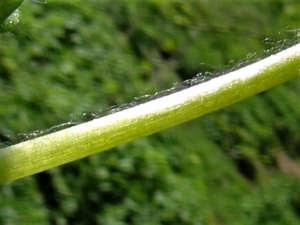
The key to identifying this plant is to look closely at the stem. Look for a line of hairs running the length of the stem. When it reaches leaves the line changes location, but it will still be there.
Chickweed is loved by chickens, but it should also be loved by humans as its soft green leaves and tender stems make an excellent addition to salads. Pick the top 5 or 10cm to get the most tender parts, and enjoy the delicate white flowers in your wild salads. Once you have tried this you probably won’t bother growing lettuces again – untroubled by slugs and abundant what’s not to like.
Ground Elder
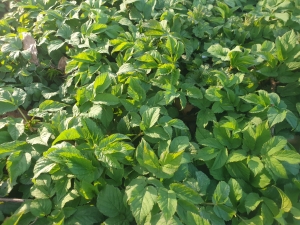
This one has gardeners quaking in their wellies. The low growing masses of single stems baring their simple terminal leaf then two opposed pairs will soon take over a garden. The trick to confirming you have ground elder is by looking at the lowest pair of leaves. These will be in a process of dividing to create more pairs of leaves. Look for a notch in the edge of the leaf, this is where the split will occur. Late in the spring or early summer, once the stems have got to 30 or 40cm tall, multiple umbrellas of small white flowers will appear on separate stems coming from the base reaching above the leaves. Ground elder spreads under the ground via a mass of spreading roots, sending up leaves and flowers every so often along their length. These roots will pass through other plant roots and deep into the ground.
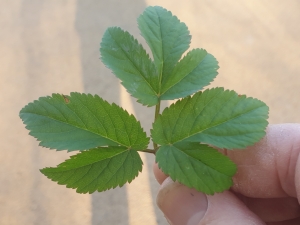
Once you have ground elder you aren’t going to get rid of it.
The good news is it is a fantastic edible plant, and if you can’t beat it, eat it. Pick the young bright green leaves for use in salads, and the older leaves for cooking like spinach. The flavour is quite parsley like, unsurprising as it is in the same group, the apiace (carrots) or umbillifer family (so named for their umbels – umbrella shaped – clusters of flower). Get the shears out and crop your mature leaves (don’t bother with the much older dark green leaves, these will be tough), steam them and make a ground elder quiche or ground elder fritatas. Any spare bag, blanche them and put them in the freezer for use another day.
Hairy Bittercress
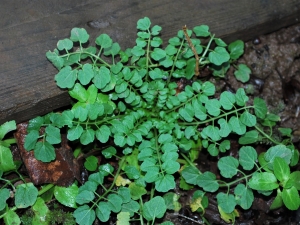
This is my favourite little green plant, and the great news is it is in everyone’s gardens, and if you don’t think it is, look harder, look in the corners, look under the roses and hydrangeas, look in mossy parts of the lawn, it will be there. It is a pioneer plant moving into open soil early and reproducing quickly, so those well dug weed free borders are the perfect spot for it to get established.
Look out for rosettes (emerging from a centre) of stems bearing small round leaves in pairs on opposite sides of a straight stem. These rosettes can start at 1cm, usually reaching a maximum of about 10cm, but sometimes becoming a tangled mass up to 20cm wide. The flower stem comes up from the centre and branches, reaching up to 30cm, the leaves on this stem are longer. The small white flowers (up to 1cm but usually 1 to 3mm) have four petals and turn into long seed pods. This gives us a clue as to its group, it is in the brassica or cabbage family. When dry these seed pods will burst open when touched, spraying tiny seeds up to 1m away from the plant. Those seeds can then grow and produce their own seeds in a matter of weeks.
The plant soon grows in profusion in any untended ground becoming a carpet in a few months. It also loves pots and troughs, the soft ground around and under plants gives it an ideal opportunity to grow and reproduce, potentially food and water from reaching the intended plant.
So what good is this speedy invader? The leaves of this plant have one of the best flavours I know, the clue is in the name, ‘cress’. They aren’t at all bitter but do have a lovely cress flavour and really add to a salad or even better, in a sandwich. The flowers are just as edible, but the thicker the stem the tougher it gets. When you pick or weed the plant, tear the roots off so as to stop the soil from getting mixed in with the leaves (a good strategy for all foraging, soil being brilliant but not tasty), then pinch out the best looking sprigs of leaves for your salad. Give them a good wash and munch away.
So 5 good tasty plants some of which will be in even the best tended garden. If you want more detail on each one look them up in our hedgerow guide here, or they are all in our Pocket Foraging Guide available from our shop foraging.co.uk. Keep safe and enjoy the outdoors when you can.


Leave a Reply